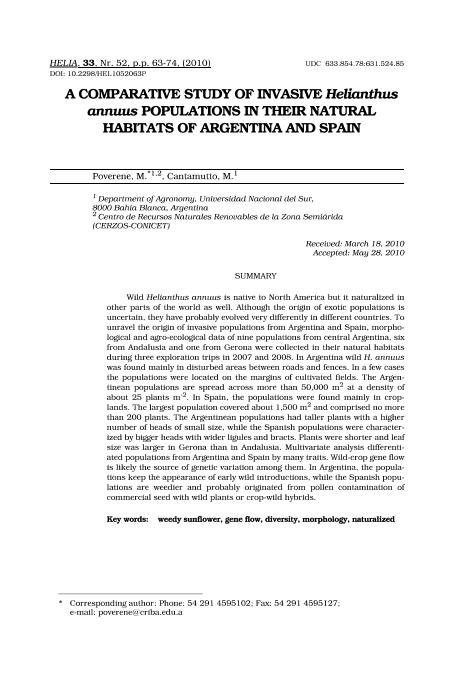Artículo
A comparative study of invasive Helianthus annuus populations in their natural habitats of Argentina and Spain
Fecha de publicación:
28/05/2010
Editorial:
Institute of Field and Vegetable Crops
Revista:
Helia
ISSN:
1018-1806
Idioma:
Inglés
Tipo de recurso:
Artículo publicado
Clasificación temática:
Resumen
Wild Helianthus annuus is native to North America but it naturalized in other parts of the world as well. Although the origin of exotic populations is uncertain, they have probably evolved very differently in different countries. To unravel the origin of invasive populations from Argentina and Spain, morphological and agro-ecological data of nine populations from central Argentina, six from Andalusia and one from Gerona were collected in their natural habitats during three exploration trips in 2007 and 2008. In Argentina wild H. annuus was found mainly in disturbed areas between roads and fences. In a few cases the populations were located on the margins of cultivated fields. The Argentinean populations are spread across more than 50,000 m2 at a density of about 25 plants m-2. In Spain, the populations were found mainly in croplands. The largest population covered about 1,500 m2 and comprised no more than 200 plants. The Argentinean populations had taller plants with a higher number of heads of small size, while the Spanish populations were characterized by bigger heads with wider ligules and bracts. Plants were shorter and leaf size was larger in Gerona than in Andalusia. Multivariate analysis differentiated populations from Argentina and Spain by many traits. Wild-crop gene flow is likely the source of genetic variation among them. In Argentina, the populations keep the appearance of early wild introductions, while the Spanish populations are weedier and probably originated from pollen contamination of commercial seed with wild plants or crop-wild hybrids.
Palabras clave:
Weedy Sunflower
,
Gene Flow
,
Diversity
,
Morphology
,
Naturalized
Archivos asociados
Licencia
Identificadores
Colecciones
Articulos(CERZOS)
Articulos de CENTRO REC.NAT.RENOVABLES DE ZONA SEMIARIDA(I)
Articulos de CENTRO REC.NAT.RENOVABLES DE ZONA SEMIARIDA(I)
Citación
Poverene, Maria Monica; Cantamutto, M.; A comparative study of invasive Helianthus annuus populations in their natural habitats of Argentina and Spain; Institute of Field and Vegetable Crops; Helia; 33; 52; 28-5-2010; 63-74
Compartir
Altmétricas




